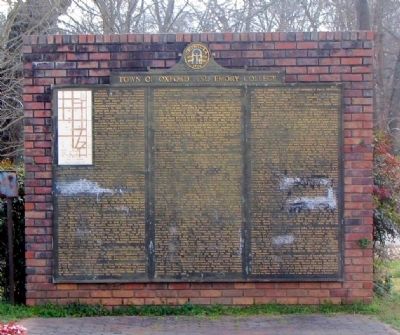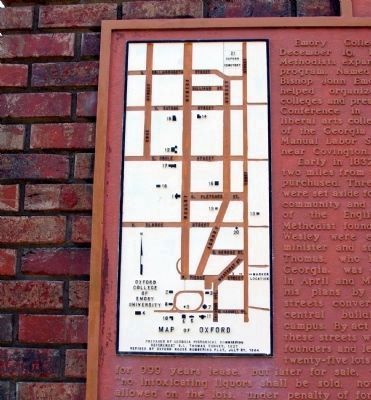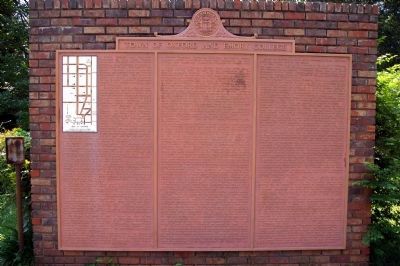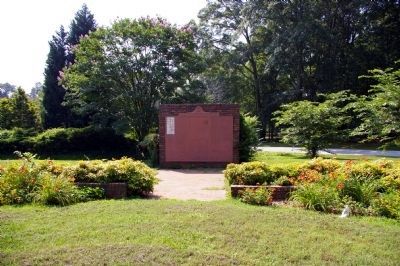Oxford in Newton County, Georgia — The American South (South Atlantic)
Town of Oxford and Emory College
Early in 1837, 1,452 acres of land two miles from the labor school, were purchased. Three-hundred thirty acres were set aside for a Christian collegiate community and named Oxford in honor of the English university where Methodist founders John and Charles Wesley were educated. A Methodist minister and surveyor, Edward Lloyd Thomas, who had planned Columbus, Georgia, was chosen to plan Oxford. In April and May 1837, he completed his plans by which Oxford’s main streets converge on the site of the central building of the college campus. By act of the College Trustees, these streets were named for Methodist founders and leaders. One hundred and twenty-five lots were offered, originally for 999 years lease, but later for sale, with the provision that “no intoxicating liquors shall be sold, nor any game of hazard allowed on the lots, under penalty of forfeiture.”
Dr. Ignatius Alphonso Few was elected first president of the college on December 8, 1837 and other members of the faculty were chosen, among them Dr. Alexander Means. The cornerstone of the first building was laid in the spring of 1838. The freshman and sophomore classes were organized on September 17, 1838. Dr. Few resigned in July 1839, due to frail health; and on December 23, 1839 the Town of Oxford was incorporated.
From then until Emory College moved to Atlanta in 1919 to become the College of Arts and Sciences of Emory University (chartered January 25, 1915 by the Methodist Episcopal Church, South), the histories of Oxford, this college and Methodism are almost inseparable. In 1919, however, the historic ties were not broken. Emory College lives on as Emory University's undergraduate division. The university’s junior college, established in 1929 and once called Emory-at-Oxford, flourishes here as the oxford College of Emory University.
The following numbered items, keyed to a map of Oxford, are some of the most historic people, places and events in the town’s, the college’s and the denomination's much entwined history:
1. “Old Church,” central section built in 1841 (two wings added 1878), more than any other building represents the ties between Oxford, Emory and Methodism. Commencement exercises were first held here in 1843 and thereafter this was the scene of great commencements,
orations and sermons.
Here during the great religious awakening of the 1850’s, Young J. Allen, Class of ’58, whom the Chinese called Lin Lo Chih and the Church called “The Man Who Seeded China,” decided to become a foreign missionary. On Thanksgiving Day 1880, Dr. Atticus G. Haygood delivered his famous sermon, “The New South.”
2. Phi Gamma Hall built in 1851 to house the first of the literary and debating societies, is an outstanding example of the Greek Revival literary society temple. George W.W. Stone, later distinguished professor of mathematics, presided over inaugural meetings held prior to 1840. Literary societies were a most important semi-formal part of the ante-bellum, classically-oriented college curriculum.
3. Few Hall built in 1852 to house the Few Society, an outgrowth of Phi Gamma, organized August 10, 1839, is outstanding Greek Revival architecture. Few and Phi Gamma, rivals both in debate and for members, were intellectual fraternities which helped to educate students and improve the college.
4. Soldier’s Cemetery. During the Civil War, the literary society buildings served as hospitals where both Confederate and Union soldiers were cared for. Twenty-five Confederate soldiers were buried here.
5. Seney Hall is a Victorian Gothic, three-story brick Administration building built in 1881 on the
foundations of the first Administration Building, a Greek Revival structure erected between 1852-53 and torn down in 1872. Seney Hall was constructed during the progressive post-Civil War administration (1875-84) of Atticus G. Haygood (b. 1839 - d. 1896), graduate of Emory College in 1859 and Methodist minister. Haygood increased the college endowment from
$13,000 to $97,000, and increased the number of degrees granted from 14 to 1876, to 25 in 1883. His liberal New South philosophy was expressed in
numerous sermons, lectures and books. His 1880 Thanksgiving Day sermon (see no. 1), which came to the attention of George I. Seney, a Methodist layman of New York City, resulted in Seney’s giving Emory College $130,000, of which $50,000 built Seney Hall. The Seney Hall tower bell was given to the college by
Dr. Alexander Means to whom it had been presented about 1855 by Queen Victoria of England.
6. “Language Hall,” built in 1874, was one of several buildings constructed during President Osborn L. Smith’s administration (1871-75) with funds raised by Bishop George Foster Pierce, President of Emory College from 1848 to 1854.
7. “Science Building,” built in 1875 under President Smith’s administration.
8. Prayer Chapel, built in 1875 under President Smith’s administration.
9. Few Monument, a marble shaft erected about 1855 by the Grand Masonic Lodge of Georgia in memory of Ignatius A. Few (b. 1789 - d. 1845), first President of Emory College (see no. 12).
10. “Old Gym” was built in 1885 during the presidency (1884-88) of Dr. Isaac Siles Hopkins (b. 1841 - d. 1914) to house his pioneering technological department. Because of his interest in technological training, Dr. Hopkins was chosen in 1888 to be the first President of Georgia Institute of Technology. With his departure from Emory College, this shop became a gymnasium.
11. Candler Hall, was built as a library in 1897 in the Neo-Roman style made popular by the 1893 Chicago Exposition. Against his wishes, it was named in honor of Warren Akin Candler (b. 1857 - d. 1941), president of Emory College from 1888 until the spring of 1898 when he was elected a bishop of the Methodist Episcopal Church, South. As Chairman of the commission created in 1914 to consider making a new Methodist university east of the Mississippi, Bishop Candler was one of the founders of Emory University.
12. The President’s Home, once described as “Greek Revival with Victorian trimming,” is especially historic. Many Emory College presidents have lived here since it was begun about 1837 by Ignatius A. Few, first president (1837-39) of Emory College and a founder of both the College and the town. Successive owners have enlarged the original small structure. Dr. Few, as President of the Manual Labor School near Covington, was one of those responsible for Oxford’s being the site of the expansion of the labor school into a liberal arts college.
Augusts Baldwin Longstreet (b. 1790 - d. 1870), Emory’s second president (1840-48) purchased the house from Dr. Few in 1839. Judge Longstreet added the two projecting front rooms which given the front porch, with its trellised columns, the effect of a recessed entrance portico. Previously active in Georgia politics (1821-25) and author (Georgia Scenes, 1827), Longstreet became a Methodist minister in 1838. His popularity and well-known abilities lent prestige to young Emory College during his presidency. Later when Judge Longstreet was President of the University of Mississippi, his son-in-law, Lucius Quintus Cincinnatus Lamar, Jr., the most distinguished Emory graduate (1845) of the early years began a Mississippi political career which eventually led to his appointment to the United States Supreme Court. The Lamar School of law at Emory University was named for him.
In 1848 George Franklin Pierce (b. 1811 - d. 1884) became Emory’s third president (1848-54) and acquired Longstreet’s home. Pierce, a leading Methodist minister, had served as President of the Georgia Methodist Conference’s Female College (later Wesleyan) at Macon. Actively interested in the momentous problems of the ante-bellum Methodist Church and delegate to numerous general conferences in the late forties and fifties, he was elected Bishop in 1854.
Atticus G. Haygood (see no. 5), eighth president of Emory (1875-84) and later Bishop, lived in this house.
In 1889 Young L. G. Harris, member of the Board of Trustees for whom Young Harris College is named, presented the house to the college at its official Presidents’ home. The last three presidents before Emory College moved to Atlanta lived here: Warren A. Candler (1888-98), Charles E. Downman (1898-1902), and James Edward Dickey (1902-15).
13. The Alexander Means’ House, owned by Dr. Means (b. 1801 - d. 1883) when Oxford was laid out in 1837, was built by a Virginian in the early 1820’s. It is the oldest house in Oxford. Dr. Means, a Methodist minister, physician, and professor of natural science, probably acquired and remodeled the house at some point between 1834, when he began serving as superintendent of the Manual Labor School near Covington, and 1837, when he helped to found Emory College and Oxford. Alexander Means, who called his porticoed Creek Revival house, “Orna Villa,” is one of the most famous personalities associated with the town and college he helped to found. As professor of natural science from 1838 until 1855, he was a pioneer in scientific education; during those years in his spare time, he lectured on chemistry at the Augusta Medical College; he preached; he served as president of Southern Masonic College at Covington; and in 1854-55 was President of Emory College. Dr. Means was fascinated by electricity, which he called “God’s vice-regent;” some believe that in the 1850’s in the old Emory laboratory he made the first American demonstration of electric light. Undoubtedly abreast of the latest scientific knowledge of his time, he was a member of many learned societies. He died in Oxford at the age of eighty-two and is buried in the Oxford Cemetery.
14. The Stone House was built on the highest point in Oxford by Edward Lloyd Thomas, the surveyor and Methodist minister, soon after he had planned Oxford in 1837. In 1854, two years after Thomas’ death, the house was purchased by Professor George W.W. Stone who was graduated from Emory College in 1842 and made a member of the faculty, serving, with only a brief interruption, from that time until shortly before his death in 1889. The Stone House with the Means’ House (no. 13), the Branham House (no. 15), the President’s Home (no. 12), and the Dickson House (no. 16) are the outstanding examples of private homes where Emory College students were boarded. Until the Haygood Dormitory was built in 1912, dormitories were considered to be “facilities for mischief.”
15. The Branham House, Greek Revival, built around 1840 (see no. 14).
16. Capers Dickson House, Greek Revival, built around 1840 (see no. 14).
17. Hopkins House, built about 1850. In a workshop behind the house, Dr. I.S. Hopkins began experiments in technological education, which led in 1888 to his being elected the first President of Georgia Tech. (see no. 10).
18. “Kitty’s Cottage” location. Kitty was a mulatto slave girl willed to Bishop James O. Andrew, President of the Board of Trustees of Emory College, with the stipulation that at age nineteen she was either to go to Liberia or remain as free as the law and society of Georgia would permit; her decision to remain in Oxford, technically the slave of a Methodist Bishop, partly brought about the organization in 1845 of the Methodist Episcopal Church, South. Kitty’s Cottage was moved in 1938 to Salem Campground near Covington.
19. “Zora Fair's Cottage.” In November 1864, Miss Izora M. Fair, refugeeing from Charleston, S.C. in Oxford, disguised herself as a country negress and attempted to sneak into besieged Atlanta. She was fired on by Sherman’s pickets, taken to guard’s quarters, questioned, and sent back to Oxford; she is Oxford’s “Confederate Girl Spy.”
20. The Yarbrough Oak or the “Prince of the Forest” is a large, old White Oak that owns itself. In the 1870’s the Rev. John W. Yarbrough, Dr. Atticus G. Haygood’s father-in-law, began a Yarbrough family tradition of devotion to this magnificent tree, which inspired the commissioners of Oxford to deed the tree to itself on September 30, 1929.
21. Oxford Cemetery, called the “Westminster of Georgia Methodism,” was part of the original town plan. Taken with “Old Church” (no. 1), it speaks most eloquently for the historic ties between the Town of Oxford, Emory College and Methodism. Buried here are eight Presidents of Emory College, three of whom became Bishops of the Methodist Church, and many both great and humble who might echo Justice L.Q.C. Lamar’s words uttered in July 1870: “No spot on earth has helped to form and make me what I am as this town of Oxford.”
Erected 1966 by Georgia Historical Commission. (Marker Number 107-09.)
Topics and series. This historical marker is listed in these topic lists: African Americans • Arts, Letters, Music • Cemeteries & Burial Sites • Churches & Religion • Education • War, US Civil. In addition, it is included in the Georgia Historical Society series list. A significant historical date for this entry is January 25, 1915.
Location. 33° 37.266′ N, 83° 52.122′ W. Marker is in Oxford, Georgia, in Newton County. Marker is at the intersection of Whatcoat Street and Pierce Street, on the left when traveling south on Whatcoat Street. Touch for map. Marker is in this post office area: Oxford GA 30054, United States of America. Touch for directions.
Other nearby markers. At least 8 other markers are within 2 miles of this marker, measured as the crow flies. Town of Oxford, Georgia Historic Shrine of the United Methodist Church (approx. 0.2 miles away); Old Church - 1841 (approx. 0.3 miles away); Old Church (approx. 0.3 miles away); Old Emory Church (approx. 0.3 miles away); Kitty's Cottage (approx. 0.3 miles away); The Old Oxford Church (approx. 0.3 miles away); Garrard’s Cavalry Raid (approx. 1.4 miles away); The Stoneman Raid (approx. 1.4 miles away). Touch for a list and map of all markers in Oxford.
More about this marker. This is the largest historical marker in Georgia.
Additional commentary.
1. Emory University Academy
I have found a long picture of high school age boys that are all wearing the same military type uniforms, my father is one of them he is 18 years old. Inside this picture there is a parchment with Emory University Academy Oxford Georgia. It says my father Alton K. Kirkpatrick has completed sixteen units of High School. This is May 13, 1927. Was this Academy part of or the start of Emory University? Are any of the buildings from 1927 still there if the answer to above question yes. There is a family story about my father attending this Academy.
Editor's Note: Emory University Academy and Emory Junior College shared the same campus after 1929. In the 1960s, the Oxford College of Emory University was formed from these two programs and continues to this day. Many graduating two year students go on to study at Emory and other affiliated schools. Some of the older buildings still remain; Phi Gamma Hall (completed in 1851) being the oldest. Seney Hall, built 1881, still stands as well, and is featured in the opening scenes of the old Dukes of Hazard television show.
— Submitted June 12, 2009, by Nina Jo Hoover of Felton, Pennsylvania.
Credits. This page was last revised on November 17, 2019. It was originally submitted on September 7, 2008, by David Seibert of Sandy Springs, Georgia. This page has been viewed 4,219 times since then and 63 times this year. It was the Marker of the Week September 14, 2008. Photos: 1. submitted on September 7, 2008, by David Seibert of Sandy Springs, Georgia. 2, 3, 4. submitted on June 23, 2009, by David Seibert of Sandy Springs, Georgia. • Craig Swain was the editor who published this page.
Editor’s want-list for this marker. • Photos of the points of interest listed on this marker • Can you help?



